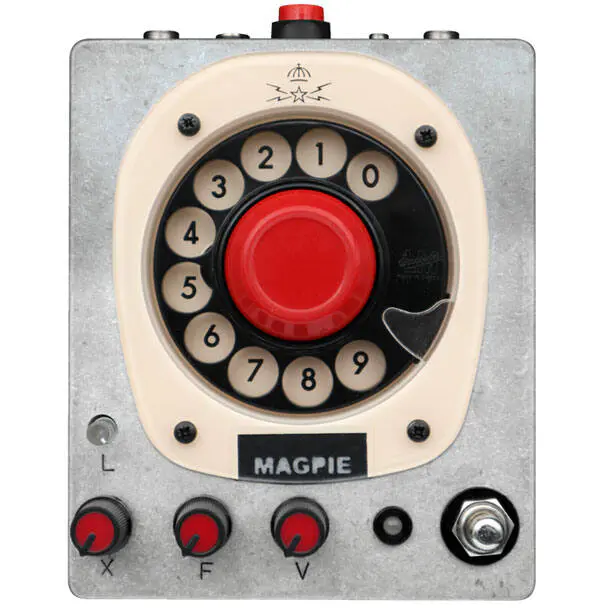
Those who are not familiar with Swedish mad scientist Simon the Magpie miss out on some bizarrely genius stompboxes, and synths. The Stutterphone V2 is the new version of a stunning pedal that embeds a vintage rotary phone dial. Even better, it promises to loop… silence!
This new version does what V1 did but also introduces a new, “Green” mode, and a few extra innovations and upgrades.
Just like the first instance of the pedal is a kill switch that cuts the signal either by pressing the big red button in the center of the dial, or by dialing a number in the rotary, which generates some sort of short square tremolo effect until the dial is back in its original position.
This effect can be reversed by pushing the red button on the top side of the case: in this reverse mode, the pedal will be silent until the big red button is pressed or will pass stuttering audio when the rotary dial is spinning.
The stuttering in V2 is greatly improved through an electronic circuit, sounding smoother and not as glitchy and noisy as it did in the original, where it was generated mechanically by the analog rotary dial.
This stutter effect is joined by a fuzz, which can be introduced through the X knob, which works as a blend of clean and fuzzed-up signal. The F knob mixes two fuzzes, a darker and a sharper fuzz, while the V knob sets the pedal’s output level.
However, the new and exciting feature of this V2 is something else entirely: right, the silence looper… let’s see what this is all about.
Holding the footswitch for about a second turns on GREEN MODE/LOOP MODE – the pedal’s light will turn to green.
This mode activates a looper whose length is controlled by the transparent LED knob on the left of the pedal. Neatly, the green light will turn orange whenever the loop is starting a new cycle.
But this looper does not record your audio but – as promised – the silence you input through the large red button, or rather, the rhythm of your kill switch pattern! So yes, it loops the silence! This allows the creation of rhythmic patterns, which can then be reset by holding the red button for a second or so.
Synth users will be ecstatic to learn that the Stutterphone can be synched to external devices (like an arpeggiator’s clock source) via a 5v cable connection. As if that wasn’t enough, dialing in a number in the rotary when the device is synched will skip as many steps as the number dialed. To use the builder’s words: “Simply dial up a number and the microcontroller will disregard that number of clock steps before it restarts the loop.”
By the way, the reverse function can be applied also to Loop Mode.
Check out what this crazy machine can do, in Simon’s presentation video.
Simon the Magpie Stutterphone V2, Builder’s Notes
The Stutterphone is built upon one of my oldest pedal ideas. Originally taking apart vintage rotary phones and simply passing the signal through the inside mechanics to use both the rotary dial and big red button as killswitches.
In the new Stutterphone V.2 the signal is never mechanically broken. Instead the rotary dial and big red button are connected to a microcontroller that controls a “silencer” I have designed. This is to avoid the pop sounds occuring when mechanically cutting an audio signal.
For the first official Magpie Pedals Stutterphone I also designed a fuzz. This is of course included in the Stutterphone V.2! But I have added a clean mix so you can dial it in yourself. (I also tweaked the volume knob to double as a clean boost).
MAUNAL OR LOOP:
Additionally the Stutterphone V.2 now has two different modes of operation (Press and hold the bypass footswitch for about 1-2 seconds to change mode):Red Mode (Manual/Original): Manually use the big red button or rotary dial to either silence your signal or let it pass through (depending on the backmounted red button).
The Stutterphone V.2 always starts in RED mode when powering up.Green Mode (Loop): In loop mode you can record up to 10 moments of silence/signal on a constant loop. These moments can range in time, but can only be recorded with the big red button (not the rotary dial).
The loop lenght is controlled either with the clear mini pot or with a 5V CV Clock connected to the 3.5mm jack on the back. With a clock source connected you can use the rotary dial to “skip” steps. Simply dial up a number and the microcontroller will disregard that number of clock steps before it restarts the loop.Lastly there is now also a red button on the back of the Stutterphone. This button inverts the function of the microcontroller. Meaning that the Stutterphone is set to silent and only lets audio pass through on “button presses”.























